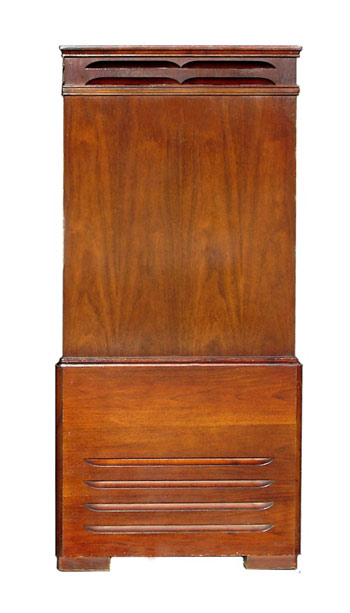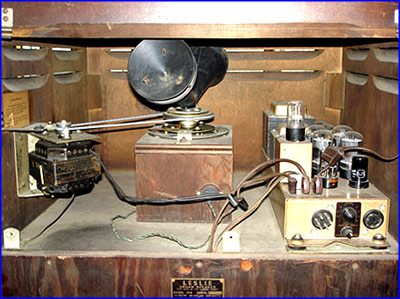LESLIE SPEAKERS
North Suburban HAMMOND ORGAN Service
Here's a look at a tall Leslie, as exemplified by the model 31H. Although these units are rare today, you can still find them not only in active use, but also for sale on eBay. If you don't mind their big size, you will be very pleased by what they can do for the sound of a traditional tonewheel Hammond. In spite of their large size and the difficulty of moving them around, they are preferred by many to the more modern Leslies.

Figure 6.Typical 31H Leslie speaker cabinet.
These speakers are around 5 feet tall, and in my opinion, the general design appearance is not quite as visually pleasing as that of the later Leslies such as the 122. But for the purist who wants the original Leslie speaker on his Hammond and which generally provides better bass than you get from the newer Leslies, then these tall Leslies are the answer. Unlike the more modern traditional Leslies with a 40 watt RMS power amplifier, the 31H speakers had a 30 watt unit. Also, they were equippped with electro-dynamic woofers instead of the permanent magnet units in newer production.
The overall sound is very similar to that of the later type, but because of the much larger central compartment, the bass response is typically better. Also, some claim the higher physical level of the top horns makes high frequency dispersion of the signal a little better in a typical room. There is much subjective opinion on the 31H vs. the newer type, and there are some who absolutely insist that the 31H is far superior and that they can instantly tell the difference. Perhaps.....but with the exception of different bass, I fail to hear a significant difference between the 31H and the later types. Rather, I have noticed profound differences in particular individual setups, where the same speaker cabinet on the same model instrument gives a very different sound. I have heard 31H cabinets on instruments with lousy bass response, and I have heard 122s with fantastic bass.

Figure 7. Looking into the upper compartment of a typical 31H tall Leslie, showing all major components. Notice that in these older Leslies, there is only 1 motor and that it drives the treble rotors only at tremolo speed. Although hard to see in the picture, if you look carefully you will note the three speed pulley and that the drive belt is in the center groove. Belt tension is maintained by a coil spring which pulls the motor-mounting plate to the left.
I suspect in a significant number of cases that the owners of 31Hs will say that their Leslies are better, and that the owners of 122s and 147s say that theirs are better, and then there are also some (myself included) who like the sound of a Hammond played through a straight Hammond speaker cabinet such as a PR40 better than any Leslie at all. Anyhow, now that I have stated my "two-cents' worth" of personal opinion, we'll continue. The next picture is one that I downloaded from the web. It is courtesy of Tom Petro and it shows the inside of the top compartment of a 31H. Notice the power amplifier chassis to the lower right, and also that there is a special plywood platform for the treble driver and the treble rotary horns. The single speed (tremolo only) motor is to the left, and this picture also shows the drive belt and the motor pulley for the top rotor.
We must also consider the new Leslie simulators which have appeared on the electronic music scene in recent years. If you read the article on vibrato, read the section on polyphase vibrato, which is where a number of different vibratos are produced simultaneously. They all run at the same rate, but their phases are different, meaning that when one is going sharp, another phase of the vibrato may have already reached its sharp peak and is starting to decrease in pitch.
A polyphase vibrato, when different parts of it are played through a stereo speaker pair sounds very much like Leslie tremolo, which in itself is an infinitely complex polyphase vibrato. If we also add a degree of stereo tremolo (aslo discussed in the vibrato article) the realism becomes even better.
I will be the first to say that if you are in the same listening area with a real Leslie, or more than one Leslie, the effect is more "live" and "bigger" than the effect that you get with a Leslie simulation. However, if you are making a recording, then the recorded results of a good Leslie simulator are [again my opinion] at least as good if not slightly better. As I mentioned before, when you record a real Leslie, you must use microphones. Recordings directly from the audio signal(s) while they are still AC waveforms have a cleaner and more even response, and thus I no longer use any Leslie speakers at all. I sold the 31H I had years ago, and unfortunately the 251 that I also had was destroyed by fire when the venue where I had used it last had a small fire. For the last 15 years, I have relied for all of my electronic instrument use on a good 50 watts/channel stereo amplifier and a pair of studio monitor speakers, and I use digital signal processing for Leslie simulation as well as reverb, echo and chorus effects. This is also practical if you have (as I do) a relatively small house and massive tone cabinets for different instruments would take up a lot of scarce room. And annoy the wife! The above setup works very well for all kinds of electronic instruments.
Previous Page Page 7. Next page